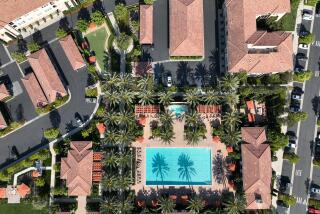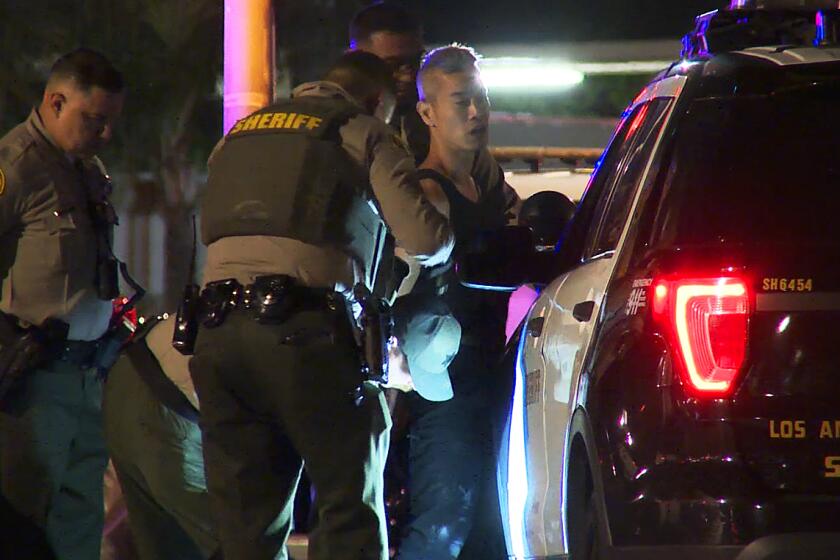Chief vows full inquiry into violence
Los Angeles Police Chief William J. Bratton on Wednesday expressed “grave concern” about his officers’ tactics in dispersing a crowd at an immigration rights rally, where police wielded batons and fired 240 “less-than-lethal” rounds at demonstrators and reporters.
Bratton promised an aggressive investigation as public outrage grew over the police actions Tuesday that left at least 10 people with minor injuries -- including seven reporters -- and raised serious questions about whether officers overreacted when they moved aggressively to disperse a largely peaceful crowd. Eight officers were treated for minor injuries at the scene.
For the record:
12:00 a.m. May 4, 2007 For The Record
Los Angeles Times Friday May 04, 2007 Home Edition Main News Part A Page 2 National Desk 3 inches; 111 words Type of Material: Correction
MacArthur Park melee: A photo caption on Thursday’s front page accompanying an article about the melee in MacArthur Park during an immigration rights rally stated that a Los Angeles police officer “picks up KCBS cameraman Carl Stein to move him out of the way.” Stein said that he was videotaping the rally when police knocked him down. The image showed Stein, who was on his knees, being grabbed from behind by police officers who were forcing him forward. Also, another article about the melee in Thursday’s Section A incorrectly referred to the USC Annenberg Institute for Justice in Journalism. The correct name is the USC Annenberg Institute for Justice and Journalism.
“The treatment you received yesterday from some Los Angeles police officers ... we can’t tolerate and won’t tolerate,” Bratton told reporters at a City Hall news conference, extending his remarks to members of the public also caught up in the incident.
Bratton and top LAPD officials acknowledged Wednesday that there might have been significant problems with how the police handled the incident -- including how the order to clear the crowd out of an area where organizers had a permit to stay until 9 p.m. was issued.
Bratton said that the initial order appeared to have come from a helicopter, but it was unclear whether the craft was hovering over the park or a crowd of agitators nearby. The order was made in English only, and some reporters and protesters said they either did not hear any orders or could not understand what the police wanted them to do.
Questions also were raised about the large number of projectiles fired by officers attempting to control the crowd. At least 240 rounds made of foam, sponge or fiber were fired as police swept through the park about 6:15 p.m. The move came after police clashed with a small group of protesters near the intersection of 7th and Alvarado streets.
“Two hundred and forty rounds with no arrests is of grave concern to me,” Bratton said, acknowledging that none of the rounds fired were directly related to the arrests of eight adults and one juvenile during the rally on charges that included assault with a deadly weapon in a rock-throwing incident and public drunkenness. The chief labeled some of the officers’ actions “inappropriate.”
Also under investigation is what role commanders on the scene played in directing police response.
High-ranking LAPD sources, who spoke on the condition that they not be named, told The Times that neither the incident commander, Deputy Chief Caylor “Lee” Carter, nor the captain in charge of the deployment were on the skirmish line as officers confronted the crowd, raising questions about who was guiding the officers’ actions.
Focus of inquiry
Andre Birotte, the LAPD’s inspector general, said his office would focus in part on why officers used foam rounds on reporters and marchers that videotapes seemed to indicate were not posing a violent threat. According to the LAPD’s manual, “less-than-lethal” devices should used only on “violent or potentially violent suspects.”
“Some of the images are very troubling,” Birotte said.
Police union leaders urged Wednesday against a “rush to judgment.”
“Our officers gave a legal dispersal order and were met with violence. In the coming days it will become clear what transpired,” said Los Angeles Police Protective League President Bob Baker in a statement.
The move to clear the area came after a small group of protesters, described by Bratton as involving between 50 and 100 agitators, some with bandannas obscuring their faces, began throwing rocks and plastic bottles at police. Although some reporters at the scene heard an order to disperse from the advancing officers, others did not. The order appeared to come from an officer on foot with a megaphone just north of the intersection of Alvarado and 7th.
By 6:20 p.m., after the initial rock- and plastic bottle-throwing incident spurred the decision to close down a rally that was permitted to last until 9 p.m., two lines of officers began moving northwest through the park. Officers formed a wide V and swept protesters and members of the media before them.
In footage shot by Fox News and Telemundo reporters, police officers can be seen grabbing Fox reporter Christina Gonzalez and forcefully pushing her out of the way as she crouched to protect her camerawoman, who had fallen after being struck by a police baton. “I am helping her move, sir!” Gonzalez said, her voice agitated.
The officer is heard saying: “Move her back away from the skirmish line or you’re under arrest.”
As Gonzalez, whose husband is a retired LAPD officer, struggled to regain her footing, an officer pushed her by the shoulders, spinning her around.
“You can’t do that,” Gonzalez yelled at an officer, jabbing a finger in his direction. “You cannot do that and you know it.”
Patricia Nazario, a KPCC-FM (89.3) radio reporter, said she watched as officers marched slowly in a single-file line.
“They had their batons crossed over their chests,” she said. “Some came across Wilshire shooting their bullets.”
Some in the crowd, she said, retaliated by throwing bottles and cans. Still, at that point, Nazario said, she did not feel unsafe. Within minutes, though, the perimeter closed in around her. As she tried to walk away, she said, an officer struck her in the back with a baton.
Nazario said she went to St. Vincent Medical Center’s emergency room where she was treated for her injuries.
Deeper into the park, other reporters were preparing to go live for 6:30 p.m. broadcasts, including Telemundo anchor Pedro Sevcec. He said he watched a confrontation develop between protesters and police, with about a dozen people whose faces were covered throwing water bottles at officers. Then he heard weapons being fired and saw people running and screaming.
But the area where he stood with about 40 others remained calm. He went on the air.
“The next thing I heard was the shotguns, and they were firing in our direction,” he said. “Suddenly I started seeing people falling on the ground.... It was completely ridiculous.”
Sevcec said a police officer took a camera and threw it about 15 or 20 feet. Then the police started hitting reporters and cameramen with their batons.
“Police ran us over,” he said. “Lights were flying, monitors were on the floor.”
At one point, a police officer pointed a weapon at his face. Sevcec said he was struck by a baton three times on his neck and back.
Taking notes
In addition to journalists with press credentials, others in the park carried still and video cameras and appeared to be taking notes as they walked backward ahead of the police line.
Maritza Alvarez, 36, a filmmaker, watched police from the northwest corner of the park.
“I can tell you they were just shooting indiscriminately,” she said. “I saw them beat up an elderly man, they knocked his knees down, children were crying.”
Alvarez said she and two others tried to help an old man get up as about five riot police officers kicked him after hitting his knees with a baton to knock him down.
“I’m telling you, it was military style, there was a commander there saying ‘1, 2, shoot,’ and we were trying to duck behind trees, running,” Alvarez said.
Three investigations have been launched: an overall departmental review of tactics, an internal affairs investigation into the behavior of the officers and commanders on the scene, and an independent review by the Inspector General, the investigative arm of the Police Commission.
Still, calls came Wednesday for outside scrutiny.
Assembly Speaker Fabian Nunez (D-Los Angeles) asked Los Angeles County Dist. Atty. Steve Cooley to launch an independent investigation into the LAPD’s actions.
Some longtime LAPD observers said Tuesday’s protest was reminiscent of clashes between protesters and police during the 2000 Democratic National Convention in Los Angeles in which some demonstrators and reporters were injured.
The city settled a lawsuit brought by seven reporters, in part, by agreeing to recognize journalists’ right to cover public protests even if a declaration of unlawful assembly is made and an order to disperse is issued.
“This has echoes of the DNC,” said attorney Constance Rice, who has studied LAPD management and policing issues for several years. “It suggests the old LAPD overreaction to things.”
*
andrew.blankstein@latimes.com
Times staff writers Megan Garvey, Anna Gorman, Patrick McGreevy, Jill Leovy, Francisco Vara-Orta, Tami Abdollah, Paul Pringle and Matt Lait contributed to this report.
More to Read
Start your day right
Sign up for Essential California for news, features and recommendations from the L.A. Times and beyond in your inbox six days a week.
You may occasionally receive promotional content from the Los Angeles Times.







